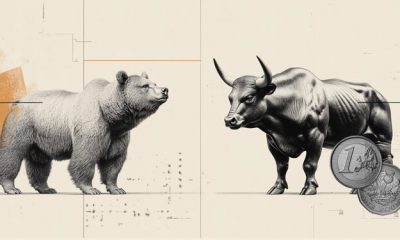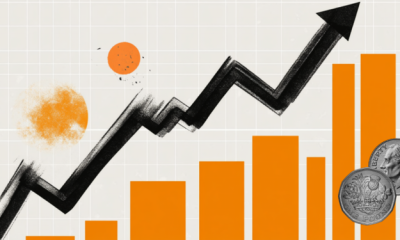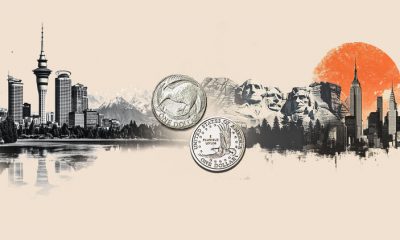

others
Australian Dollar holds ground as Q1 GDP expands 0.2% QoQ – Crypto News
- The Australian Dollar maintains its position after the release of mixed economic data on Wednesday.
- Australia’s Gross Domestic Product expanded 0.2% QoQ in Q1, against the previous 0.6% growth.
- The US Dollar faces challenges as tariff uncertainty may hurt growth in the US economy.
The Australian Dollar (AUD) appreciates against the US Dollar (USD) on Wednesday after registering over 0.5% losses in the previous session. The AUD/USD pair remains in positive territory following the release of mixed economic data from Australia.
Australian Bureau of Statistics (ABS) showed that Gross Domestic Product (GDP) grew by 0.2% quarter-over-quarter in Q1, declining from the previous 0.6% growth. Australia’s economy fell short of the expected 0.4% rise. Meanwhile, the annual GDP growth rate remained consistent at 1.3%, below the expected 1.5%.
Moreover, the S&P Global Australia Composite Purchasing Managers’ Index (PMI) fell to 50.5 in May from April’s 51.0 reading, expanding for the eighth successive month. However, the pace indicates marginal growth in business activity, albeit the slowest so far in 2025.
The S&P Global Australia Services PMI came at 50.6 in May, marking a 16th straight month of expansion but at the slowest pace in six months. The Ai Group Manufacturing PMI posted a -23.5 reading, improved slightly from the previous -26.5. Manufacturers experience delays in major projects and rising market hesitation due to global and domestic uncertainty.
Reserve Bank of Australia (RBA) Assistant Governor Sarah Hunter expressed caution on Tuesday that “higher US tariffs will put a drag on the global economy.” Hunter noted that higher uncertainty could dampen investment, output, and employment in Australia. However, she also added that Australia’s exporters are relatively well-placed to weather the storm and assumes that Chinese authorities will support their economy through fiscal stimulus.
Australian Dollar advances as US Dollar edges lower amid growing tariff uncertainty
- The US Dollar Index (DXY), which measures the value of the US Dollar against six major currencies, is trading lower at around 99.10 at the time of writing. The Greenback struggles as traders adopt caution amid rising tariff uncertainty and its potential to hurt growth in the US economy.
- Job Openings and Labor Turnover Survey (JOLTS) showed the number of job openings on the last business day of April stood at 7.39 million, increasing from March’s 7.2 million openings. This figure surprisingly came in above the market expectation of 7.1 million.
- Institute for Supply Management (ISM) Manufacturing Purchasing Managers’ Index eased to 48.5 in May from 48.7 in April. This figure came in weaker than the expectation of 49.5.
- US President Donald Trump said at a rally in Pennsylvania on Friday that he planned to double import tariffs on steel and aluminum to build up pressure on global steel producers and intensify the trade war. “We are going to be imposing a 25% increase. We’re going to bring it from 25% to 50% – the tariffs on steel into the United States of America, which will even further secure the steel industry in the United States,” he said, per Reuters.
- The US Court of Appeals for the Federal Circuit in Washington, on Thursday, temporarily put a hold on a federal court ruling and allowed President Trump’s tariffs to take effect. On Wednesday, a three-judge panel at the Court of International Trade in Manhattan halted Trump from imposing “Liberation Day” tariffs from taking effect. The federal court found that Trump exceeded his authority in imposing broad import tariffs and declared the executive orders issued on April 2 unlawful.
- House Republicans passed Trump’s “Big Beautiful Bill,” a multitrillion-dollar tax and spending package, which could increase the US fiscal deficit, along with the risk of bond yields staying higher for longer. This scenario raises concerns over the US economy and prompts traders to sell American assets under the “Sell America” trend. Policy experts anticipate Senate changes as GOP lawmakers aim to finalize the “big bill” by July 4.
- On Friday, Trump accused China of breaching a truce on tariffs reached earlier this month. Washington and Beijing agreed to temporarily lower reciprocal tariffs in a meeting in Geneva. Trump said that China had “totally violated its agreement with us.” US Trade Representative Jamieson Greer also said that China had failed to remove non-tariff barriers as agreed.
- In response, a spokesperson from China’s Ministry of Commerce said on Monday that China had complied with the agreement by cancelling or suspending relevant tariff and non-tariff measures aimed at US “reciprocal tariffs.”
- China’s Caixin Manufacturing Purchasing Managers’ Index (PMI) unexpectedly fell to 48.3 in May from 50.4 in April, falling short of the market expectations of a 50.6 expansion. However, the weekend data showed that the National Bureau of Statistics (NBS) Manufacturing PMI rose to 49.5 in May, from April’s 49.0 reading. Meanwhile, the Non-Manufacturing PMI declined to 50.3 from the previous 50.4 figure, falling short of the expected reading of 50.6. The Aussie Dollar could be impacted by Chinese economic data as both countries are close trading partners.
- RBA Minutes of its May monetary policy meeting suggested that the board viewed the case for a 25 basis point cut as stronger, preferring a policy to be cautious and predictable. The policymakers highlighted that US trade policy posed a significant and adverse impact on the global outlook, but had not yet affected the Australian economy, however, they did not persuade that a 50 bps was needed.
- The Reserve Bank of Australia (RBA) is expected to deliver more rate cuts in the upcoming policy meetings. The central bank acknowledged progress in curbing inflation and warned that US-China trade barriers pose downside risks to economic growth. Governor Michele Bullock stated that the RBA is prepared to take additional action if the economic outlook deteriorates sharply, raising the prospect of future rate cuts.
Australian Dollar finds immediate support at nine-day EMA near 0.6450
AUD/USD is trading around 0.6470 on Wednesday, indicating a prevailing bullish bias. The daily chart’s technical analysis suggests that the pair remains within the ascending channel pattern. The short-term price momentum remains stronger as the pair stays above the nine-day Exponential Moving Average (EMA). Additionally, the 14-day Relative Strength Index (RSI) is positioned above the 50 mark, indicating a persistent bullish outlook.
On the upside, the AUD/USD pair could approach 0.6537, a seven-month high recorded on May 26. A break above this initial barrier could support the pair to explore the region around the upper boundary of the ascending channel around 0.6670.
The immediate support appears at the nine-day EMA of 0.6456, aligned with the ascending channel’s lower boundary around 0.6450. A successful breach below this crucial support zone could dampen the bullish bias and lead the AUD/USD pair to test the 50-day EMA at 0.6395.
AUD/USD: Daily Chart
Australian Dollar PRICE Today
The table below shows the percentage change of Australian Dollar (AUD) against listed major currencies today. Australian Dollar was the strongest against the Japanese Yen.
| USD | EUR | GBP | JPY | CAD | AUD | NZD | CHF | |
|---|---|---|---|---|---|---|---|---|
| USD | -0.08% | -0.06% | 0.03% | -0.01% | -0.02% | -0.11% | -0.08% | |
| EUR | 0.08% | -0.01% | 0.07% | 0.06% | 0.06% | -0.04% | -0.01% | |
| GBP | 0.06% | 0.00% | 0.04% | 0.05% | 0.06% | -0.04% | -0.01% | |
| JPY | -0.03% | -0.07% | -0.04% | 0.00% | -0.08% | -0.06% | -0.06% | |
| CAD | 0.00% | -0.06% | -0.05% | -0.00% | -0.01% | -0.10% | -0.07% | |
| AUD | 0.02% | -0.06% | -0.06% | 0.08% | 0.01% | -0.10% | -0.07% | |
| NZD | 0.11% | 0.04% | 0.04% | 0.06% | 0.10% | 0.10% | 0.03% | |
| CHF | 0.08% | 0.01% | 0.00% | 0.06% | 0.07% | 0.07% | -0.03% |
The heat map shows percentage changes of major currencies against each other. The base currency is picked from the left column, while the quote currency is picked from the top row. For example, if you pick the Australian Dollar from the left column and move along the horizontal line to the US Dollar, the percentage change displayed in the box will represent AUD (base)/USD (quote).
Australian Dollar FAQs
One of the most significant factors for the Australian Dollar (AUD) is the level of interest rates set by the Reserve Bank of Australia (RBA). Because Australia is a resource-rich country another key driver is the price of its biggest export, Iron Ore. The health of the Chinese economy, its largest trading partner, is a factor, as well as inflation in Australia, its growth rate and Trade Balance. Market sentiment – whether investors are taking on more risky assets (risk-on) or seeking safe-havens (risk-off) – is also a factor, with risk-on positive for AUD.
The Reserve Bank of Australia (RBA) influences the Australian Dollar (AUD) by setting the level of interest rates that Australian banks can lend to each other. This influences the level of interest rates in the economy as a whole. The main goal of the RBA is to maintain a stable inflation rate of 2-3% by adjusting interest rates up or down. Relatively high interest rates compared to other major central banks support the AUD, and the opposite for relatively low. The RBA can also use quantitative easing and tightening to influence credit conditions, with the former AUD-negative and the latter AUD-positive.
China is Australia’s largest trading partner so the health of the Chinese economy is a major influence on the value of the Australian Dollar (AUD). When the Chinese economy is doing well it purchases more raw materials, goods and services from Australia, lifting demand for the AUD, and pushing up its value. The opposite is the case when the Chinese economy is not growing as fast as expected. Positive or negative surprises in Chinese growth data, therefore, often have a direct impact on the Australian Dollar and its pairs.
Iron Ore is Australia’s largest export, accounting for $118 billion a year according to data from 2021, with China as its primary destination. The price of Iron Ore, therefore, can be a driver of the Australian Dollar. Generally, if the price of Iron Ore rises, AUD also goes up, as aggregate demand for the currency increases. The opposite is the case if the price of Iron Ore falls. Higher Iron Ore prices also tend to result in a greater likelihood of a positive Trade Balance for Australia, which is also positive of the AUD.
The Trade Balance, which is the difference between what a country earns from its exports versus what it pays for its imports, is another factor that can influence the value of the Australian Dollar. If Australia produces highly sought after exports, then its currency will gain in value purely from the surplus demand created from foreign buyers seeking to purchase its exports versus what it spends to purchase imports. Therefore, a positive net Trade Balance strengthens the AUD, with the opposite effect if the Trade Balance is negative.
-
Business1 week ago
PENGU Rallies Over 20% Amid Coinbase’s Pudgy Penguins PFP Frenzy – Crypto News
-

 Cryptocurrency7 days ago
Cryptocurrency7 days agoWhale Sells $407K TRUMP, Loses $1.37M in Exit – Crypto News
-
Technology1 week ago
Breaking: SharpLink Purchases 10,000 ETH from Ethereum Foundation, SBET Stock Up 7% – Crypto News
-

 Blockchain1 week ago
Blockchain1 week agoBitcoin Hits All-Time High as Crypto Legislation Votes Near – Crypto News
-

 Blockchain1 week ago
Blockchain1 week agoRobinhood Dealing With Fallout of Tokenized Equities Offering – Crypto News
-

 Cryptocurrency7 days ago
Cryptocurrency7 days agoSatoshi-Era Bitcoin Whale Moves Another $2.42 Billion, What’s Happening? – Crypto News
-

 others1 week ago
others1 week agoEUR/GBP climbs as weak UK data fuels BoE rate cut speculation – Crypto News
-

 Business1 week ago
Business1 week agoS&P Global Downgrades Saks Global’s Credit Rating – Crypto News
-

 De-fi1 week ago
De-fi1 week agoOusted Movement Labs Co-Founder Sues Startup in Delaware Court – Crypto News
-
Business1 week ago
XRP Set for Big Week as ProShares ETF Launches July 18 – Crypto News
-

 Cryptocurrency7 days ago
Cryptocurrency7 days agoBitcoin Breaches $120K, Institutional FOMO Takes and House Debate Propel Gains – Crypto News
-
Technology5 days ago
Fed Rate Cut Odds Surge As Powell’s Future Hangs In The Balance – Crypto News
-
Business4 days ago
XRP Lawsuit Update: Ripple Paid $125M in Cash, Settlement Hinges on Appeal – Crypto News
-
Technology1 week ago
Hyperliquid Hits Record $10.6B OI As HYPE Price Records New ATH – Crypto News
-

 Blockchain1 week ago
Blockchain1 week agoZiglu Faces $2.7M Shortfall as Crypto Fintech Enters Special Administration – Crypto News
-

 Blockchain5 days ago
Blockchain5 days agoRipple and Ctrl Alt Team to Support Real Estate Tokenization – Crypto News
-

 others5 days ago
others5 days agoEUR/USD recovers with trade talks and Fed independence in focus – Crypto News
-
Technology5 days ago
Fed Rate Cut Odds Surge As Powell’s Future Hangs In The Balance – Crypto News
-

 Blockchain1 week ago
Blockchain1 week agoSUI Explodes Higher, Climbing Above 20-Day MA — But Can The Rally Hold? – Crypto News
-

 others1 week ago
others1 week agoTop US-Based Crypto Exchange by Trading Volume Coinbase Adds Support for DeFi Tokens SKY and USDS – Crypto News
-

 Technology1 week ago
Technology1 week agoOne Tech Tip: Click-to-cancel is over, but there are other ways to unsubscribe – Crypto News
-

 Technology1 week ago
Technology1 week agoGoogle DeepMind hires Windsurf CEO as OpenAI’s $3 billion acquisition collapses – Crypto News
-

 Cryptocurrency1 week ago
Cryptocurrency1 week agoCardano’s $1.22 target: Why traders should be aware of THIS ADA setup – Crypto News
-
Cryptocurrency1 week ago
Why Is Bitcoin Up Today? – Crypto News
-

 Cryptocurrency7 days ago
Cryptocurrency7 days agoStrategy Resumes Bitcoin Buys, Boosting Holdings to Over $72 Billion in BTC – Crypto News
-
Business6 days ago
Pepe Coin Rich List June 2025: Who’s Holding Highest PEPE as it Nears Half a Million Holders? – Crypto News
-

 Cryptocurrency6 days ago
Cryptocurrency6 days agoIt’s a Statement, Says Bitfinex Alpha – Crypto News
-

 others5 days ago
others5 days agoTop Crypto Exchange by Trading Volume Binance Announces Airdrop for New Ethereum (ETH) Ecosystem Altcoin – Crypto News
-

 others4 days ago
others4 days agoGBP/USD rallies on US PPI dip and Trump’s potential Powell removal – Crypto News
-

 others4 days ago
others4 days agoGBP/USD rallies on US PPI dip and Trump’s potential Powell removal – Crypto News
-

 Cryptocurrency4 days ago
Cryptocurrency4 days agoBitcoin trades near $119K after new all-time high; Coinbase rebrands wallet to ‘Base App’ – Crypto News
-
Business4 days ago
XLM Is More Bullish Than ETH, SOL, And XRP, Peter Brandt Declares – Crypto News
-
Business1 week ago
Democrats Announce ‘Anti-Crypto Corruption Week’ To Block CLARITY Act – Crypto News
-

 others1 week ago
others1 week agoMultiBank Group Confirms MBG Token TGE Set for July 22, 2025 – Crypto News
-

 Cryptocurrency1 week ago
Cryptocurrency1 week agoWhy is ZK proof altcoin Lagrange (LA) dropping amid a rally in crypto market – Crypto News
-

 Cryptocurrency1 week ago
Cryptocurrency1 week agoXRP price targets breakout above $3 as BTC hits fresh ATH – Crypto News
-
Technology1 week ago
Breaking: Jerome Powell Allegedly Considering Resignation Amid Trump’s Criticism – Crypto News
-
Business1 week ago
XRP Price Prediction As Bitcoin Makes News All Time Highs- Is XRP Next? – Crypto News
-

 Cryptocurrency1 week ago
Cryptocurrency1 week agoHouse Democrats Struggle to Approach ‘Crypto Week’ With Unified Front – Crypto News
-

 Blockchain1 week ago
Blockchain1 week agoXRP Whales Surge To New Highs As Price Jumps 10% – Crypto News
-

 Metaverse1 week ago
Metaverse1 week agoGoogle’s Veo 3 brings the era of video on command – Crypto News
-

 Cryptocurrency1 week ago
Cryptocurrency1 week agoNear-Term Resistance at $170 But Bullishness Stays – Crypto News
-

 others1 week ago
others1 week agoGold rises as USD aversion and tariff tensions boost safe-haven demand – Crypto News
-
Cryptocurrency1 week ago
XRP, Solana and ADA Rally, Is Altcoin Season Back This July 2025? – Crypto News
-

 Cryptocurrency1 week ago
Cryptocurrency1 week agoBitcoin and Ethereum ETFs record $3.6B inflows this week – Crypto News
-
Technology1 week ago
Peter Schiff Reignites Bitcoin Criticism, Calls 21M Supply Arbitrary – Crypto News
-

 Technology1 week ago
Technology1 week agoAmazon Prime Day Sale 2025: Best earphones and headphone deals with up to 70% off – Crypto News
-

 others1 week ago
others1 week agoJPMorgan Chase CEO Says Traders May Be Seriously Mistaken on Fed Rate Cuts: Report – Crypto News
-

 others1 week ago
others1 week agoCrypto Hacker Who Drained $42,000,000 From GMX Goes White Hat, Returns Funds in Exchange for $5,000,000 Bounty – Crypto News
-

 Blockchain1 week ago
Blockchain1 week agoUK Banks Should not Issue Stablecoins – Crypto News














